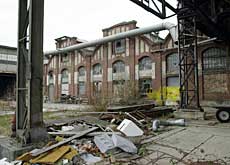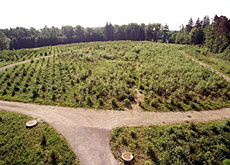Report urges regeneration of industrial land

Switzerland is sitting on a vast reservoir of untapped brownfield sites capable of generating revenue of SFr1.5 billion ($1.2 billion) a year, according to a government study.
Officials say the 17 million square metres of disused industrial land could be used to create jobs, new housing and to save the green belt.
The report, published this week by the Swiss environment agency and the Federal Office for Spatial Development, said the amount of land available was roughly equivalent in size to the city of Geneva, which is home to 190,000 people and 140,000 jobs.
“According to our estimates, unproductive industrial zones could generate revenue of SFr1.5 billion a year and a tax income of between SFr150 million and SFr250 million,” said Philippe Roch, head of the environment agency.
The study found that 80 per cent of these sites were in urban areas and that more than half of them were situated within 30 minutes’ drive for more than 500,000 people.
Many abandoned sites are the casualties of the economic downturn between 1991 and 2001 when 250,000 firms in the industrial sector closed their doors.
Notable examples include the chocolate manufacturer Suchard at Neuchâtel and the former Brown-Boveri factory in Baden.
“It’s not just private industries, but also old public establishments from the army, Swiss Post and the Swiss Federal Railways,” said Pierre-Alan Rumley, the director of the Federal Office for Spatial Development.
Raise awareness
The issue first came to light two years ago when parliamentarian Susanne Leutenegger Oberholzer called on the government to draw up an inventory of disused and contaminated sites in Switzerland and to consider ways of regenerating them.
“Each year, thousands of hectares of land in the green belt are sacrificed to make new residential, commercial or industrial areas,” said Leutenegger Oberholzer
“This is a reckless waste at a time when it would be possible to first make use of disused industrial sites,” she told swissinfo.
The government study came as a direct response to her proposal and is, according to Leutenegger Oberholzer, a step in the right direction.
“In this domain, Switzerland is lagging behind other European countries, where for a long time there have already been huge programmes to reassess brownfield sites,” said the Social Democrat parliamentarian.
Green belt
Environmentalists warn that there has been a marked decrease in the number of greenfield sites in a country where one square metre of green belt is destroyed every second.
Experts say the area running from the Jura to Lake Constance, which is home to 70 per cent of the population, is in danger of becoming one huge agglomeration.
“This evolution is the result of a short-term vision: land is not a renewable resource,” Roch told swissinfo.
“We need to save as much as possible, not only to protect nature but also to protect [our] quality of life,” he added.
Interest
However, there are signs that interest in regenerating old industrial zones is increasing.
One such example can be found in Zurich where the Escher-Wyss part of the city has been transformed into a lively area complete with a theatre, cinema, fitness centre and television production facilities.
But the report found that there were still many barriers to redeveloping these areas.
One of the biggest problems is encouraging investment, particularly at those sites that need decontaminating.
In total, the average cost of cleaning up all the land mentioned in the report would be SFr1.5 billion. Of this, SFr300 million would be for decontamination alone.
But the report concluded that it was worth investing in these sites, because many of them were in prime locations in industrial areas.
swissinfo, Armando Mombelli
There are 380 brownfield sites in Switzerland measuring more than one hectare in size.
In total, there are 17 million square metres of disused industrial land.
This is roughly equivalent in size to the city of Geneva.
In 2002 more than 20 European countries launched the Cabernet programme which aims to redevelop old industrial areas.
An appeal was made to the Swiss government the same year to consider how to reuse these sites.
If redeveloped, the land could generate SFr1.5 billion a year, says a report.

In compliance with the JTI standards
More: SWI swissinfo.ch certified by the Journalism Trust Initiative











You can find an overview of ongoing debates with our journalists here . Please join us!
If you want to start a conversation about a topic raised in this article or want to report factual errors, email us at english@swissinfo.ch.